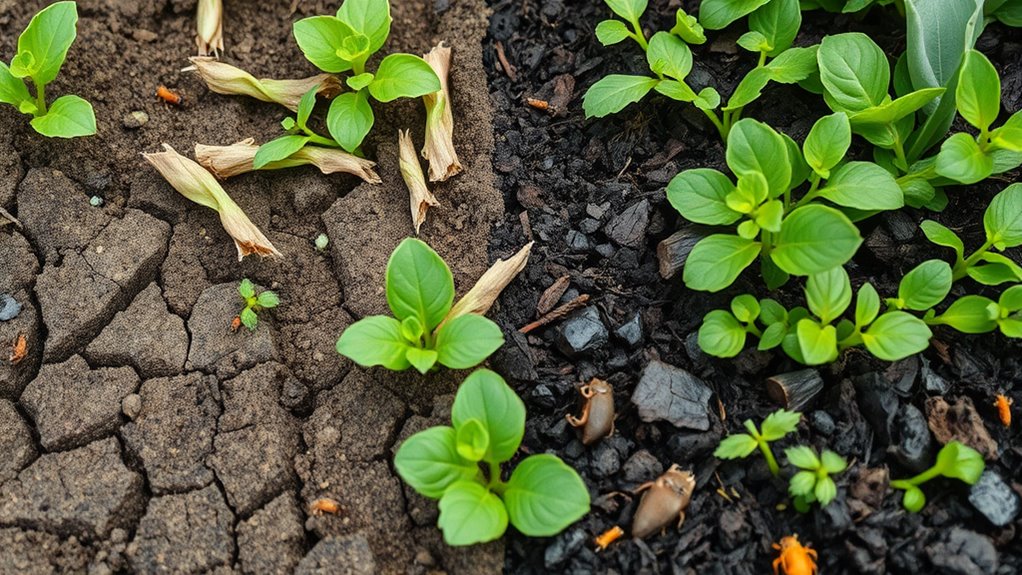Why Your Garden Soil Might Be Killing Your Plants (And How to Fix It)
If your plants are wilting, yellowing, or stunted, your soil might be the hidden killer, with issues like nutrient deficiencies, pH imbalances, or compaction blocking growth. Common causes include erosion and nutrient depletion, which hinder root development and water uptake. Start by testing your soil—grab samples, check pH and nutrients with a kit, then amend with compost or targeted fertilizers like blood meal for nitrogen fixes. You’ll revive your garden’s vigor, plus gain more strategies for ongoing soil success.
Signs of Soil-Related Plant Problems
Have you ever noticed your plants wilting even after you’ve watered them thoroughly? You might also spot yellowing leaves, stunted growth, or poor root development, signaling potential soil imbalances. Conduct soil testing to assess nutrient levels and pH accurately; it’s a practical, scientific tool that reveals hidden deficiencies without guesswork. This detailed analysis empowers you to address issues promptly, fostering robust plant health. Additionally, understanding soil pH testing can help you determine if your soil is too acidic or alkaline, impacting nutrient availability.
Common Causes of Poor Garden Soil
Poor garden soil often stems from factors like compaction, nutrient depletion, and pH imbalances, which directly undermine plant health.
You must address these to revive your garden.
Here’s how they impact you:
- Compaction: Heavy foot traffic compresses soil particles, restricting root growth and water infiltration, leaving your plants starved for air.
- Nutrient depletion: Over-farming extracts essential minerals, forcing your soil to lack nitrogen, phosphorus, and potassium, weakening plant vigor.
- pH imbalances: Acidic or alkaline conditions block nutrient uptake, making it hard for your roots to absorb what’s available, stunting growth.
- Erosion: Wind and water wash away topsoil, stripping organic matter and exposing infertile layers, exposing your garden to ongoing degradation.
In addition to these factors, reviving poor garden soil can significantly enhance the overall health of your plants and garden ecosystem.
How to Test Your Soil Effectively
To test your soil effectively, start by gathering a sample from various garden spots using a clean trowel, making sure it’s from the root zone about 6 inches deep.
After gathering, mix samples thoroughly and air-dry them.
Use a soil testing kit to measure pH and texture, noting any unusual characteristics.
For in-depth results, send to a professional lab.
This guarantees accurate assessment. Additionally, understanding soil texture can help you choose the right plants for your garden’s conditions.
Understanding Soil Nutrient Imbalances
Once you’ve tested your soil, you’ll identify nutrient imbalances that hinder plant growth.
These disrupt essential processes; here’s how they manifest:
- Nitrogen deficiency: Causes yellowing leaves and stunted growth, signaling poor protein synthesis.
- Phosphorus imbalance: Leads to weak roots and delayed maturity, affecting energy transfer in plants.
- Potassium shortage: Results in browning leaf edges and reduced disease resistance, impacting water regulation.
- Micronutrient issues: Such as iron lack, causing chlorosis and poor chlorophyll production in foliage.
Additionally, common soil preparation mistakes can exacerbate these imbalances, leading to further complications in plant health.
Practical Steps to Amend Your Soil
After identifying nutrient imbalances in your soil, you’ll tackle them head-on with targeted amendments.
Start by adding compost to boost organic matter and microbial activity. For nitrogen shortages, incorporate blood meal or urea, mixing it evenly into the topsoil. Address phosphorus deficits with rock phosphate, and correct low potassium using potash. Test amendments’ rates based on soil analysis to avoid overapplication, ensuring ideal nutrient uptake. Additionally, regularly test your soil to monitor changes in health and nutrient levels over time.
Tips for Sustaining Healthy Soil Conditions
How do you maintain healthy soil over the long term?
It’s crucial to adopt these strategies for long-term soil health and plant vitality.
- Conduct annual soil tests to accurately monitor pH, nutrients, and organic matter levels for precise adjustments.
- Add compost and other organics routinely to improve soil texture, boost microbial activity, and enhance fertility.
- Implement crop rotation and cover cropping to prevent soil exhaustion, reduce pests, and maintain nutrient balance.
- Use mulching techniques effectively to maintain moisture, control weeds, and protect soil from temperature extremes.

